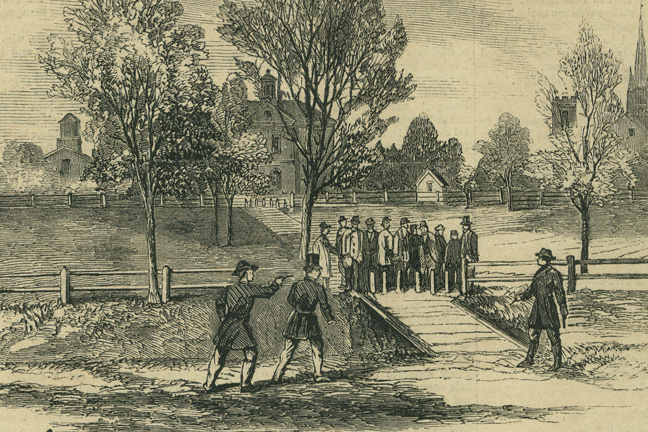St. Albans’ made attempt to punish a Confederate
ST. ALBANS CITY — In the spring of 1865, Hezekiah Payne, took a ferry from Windsor, Canada into Detroit, intending to take the woman he was dating to the theater.
Once in the U.S., Payne, age 31, was promptly arrested.
His date was working for the U.S. government.
What followed next is a little reported artifact of the better-known St. Albans Raid of Oct. 19, 1864. While not a single proven raider faced prosecution in the U.S., Payne was to become the only alleged participant to be arrested and tried on Union soil.
That trial, like the northernmost land action of the Civil War itself, took place here in St. Albans and involved a man whose name also came up during the investigation into the assassination of President Abraham Lincoln.
Payne’s arrest in Detroit occurred after he had boasted to his landlord, a fellow former Confederate soldier named Captain Smith, that he had taken part in the St. Albans Raid. Unbeknownst to Payne and other Confederates living in Smith’s hotel, Smith was an informant for the Union.
Following Payne’s boast, U.S. Army Colonel Hill, who was headquartered in Detroit, “placed a female detective on Payne’s track, who by her charms induced the latter to escort her to the theatre in Detroit on an evening,” according to a lecture on the history of the raid delivered to the Vermont Historical Society by Edward A. Sowles, of St. Albans, on Oct. 17, 1876.
Sowles had been one of a team of lawyers representing the U.S. government in a hearing seeking extradition of several alleged raiders captured in Canada.
Payne was arrested by a U.S. Marshal, “apparently very much to the disgust and chagrin of his fair companion,” according to Sowles.
Payne may have been a “fair companion” himself. He was described in a police report as being 5 feet 11 inches tall, weighing 165, with dark brown hair and gray eyes.
In the lining of Payne’s coat were bills from one of the St. Albans banks robbed during the raid.
Vermont Gov. J. Gregory Smith requested that the marshal service transport Payne to St. Albans for trial. Payne’s brother George accompanied him.
The legal case
The marshal’s service billed the state $247.25 for the cost of transporting the Payne brothers to St. Albans.
A Grand Jury was convened in March 1865, with John Pierpont, chief judge of Franklin County and a member of the Vermont Supreme Court, presiding.
George Payne told the Grand Jury that Hezekiah was living with him on St. Catherine Street in Montreal in the days before the raid. He claimed that on Oct. 19, 1864, the day of the raid, Hezekiah and George had eaten breakfast, lunch and dinner together at George’s home.
George Payne also testified that he leased his house to City Registrar Ryland on that same October date and had discussed the matter with his brother that day, although no papers were signed. George Payne said he did not have any documentary evidence to establish his brother’s presence in Montreal at the time of the raid.
The jury evidently did not find George Payne’s testimony compelling, because they indicted Hezekiah Payne, the raid’s organizer Bennett Young, and another raider Turner Teavis (sometimes spelled Tevis) of shooting Elinus J. Morrison, the only person killed in the raid. Which of the men shot Morrison, a Manchester, N.H. contractor who was in St. Albans building the Welden Hotel and believed to be a Southern sympathizer, has never been established.
Other raiders were indicted for assisting with the shooting.
The indictment lists the names of the known raiders, and continues to indict each of the three in turn for shooting and killing Morrison.
Hezekiah Payne was also indicted for an additional crime – the theft of Ed Nettleton’s hat, valued at five dollars.
Payne was tried in June, 1865 in St. Albans on the crimes of either committing or assisting in the murder of Morrison and the theft of Nettleton’s hat.
According to Sowles, the Rev. Francis W. Smith positively identified Payne as the man who had pointed a pistol at Nettleton and “compelled the latter to deliver to him his cap.” Smith was among a half dozen witnesses who identified Payne as having been part of the raid.
The alibi
Payne’s defense provided witnesses who said Payne had been in Montreal at a broker’s office at 8:30 on the morning of Oct. 20, 1864 with a number of other southerners.
“A prominent Southerner afterwards informed the writer, in Montreal, that Payne participated in the St. Albans Raid, and by dint of good luck reached Montreal at six o’clock, and delivered his booty to the Confederate treasury at that place,” wrote Sowles.
Thus, it appears that Payne’s alibi may, in fact, have been the very act of depositing money stolen during the raid.
In any case, his presence in Montreal the morning after the raid was enough to create reasonable doubt in the minds of the jurors about Payne’s presence in St. Albans on the day of the raid, and Payne was acquitted.
Following his acquittal, Payne’s name disappeared from nearly all accounts of the raid.
Other raiders, including Young, were captured in Quebec, but they were never extradited to the U.S. to stand trial. The British government took the position the raiders were soldiers and therefore not subject to the extradition treaty between the U.S. and Britain. Of the $200,000 stolen from St. Albans, $80,000 was returned by British authorities. Aside from the notes found in Hezekiah Payne’s coat, the value of which is not found in any of the documents, the rest was never recovered.
Lincoln’s death
The St. Albans trial was not the first time Payne had been arrested and tried. George and Hezekiah Payne had been arrested in Detroit on April 25, 1860 for robbery. They were acquitted. Following the assassination of President Lincoln, Wayne Van Starr, deputy sheriff of Wayne County offered to provide the Secretary of War with testimonials provided on the brothers’ behalf by “prominent persons” in the South.
Van Starr wrote that the two men regularly traveled between Canada and Detroit and following the assassination of President Abraham Lincoln, he came to believe they had been sent north to commit nefarious acts on behalf of the nascent Confederacy even though war had not yet broken out.
Payne may have been a relative of Lewis Powell, one of the men who conspired to assassinate Lincoln. Powell attacked Secretary of State William Seward in his bedroom with a knife while Seward was recovering from injuries sustained during a carriage accident.
His attack failed. Powell was tried, convicted and executed for the attack on Seward.
Powell also went by the name of Payne, and correspondence sent to Secretary of War Edwin Stanton indicates the activities of George and Hezekiah Payne were included in the investigation into the assassination.
Stanton was provided with a copy of George Payne’s testimony on behalf of his brother before the Grand Jury.
John R. Kennedy, superintendent of the Metropolitan Police in New York City, provided Stanton with a description of the men and women believed to be Lewis Powell/Payne’s siblings. It included both George and Hezekiah, who was then in custody in St. Albans.
Albert Sowles of the First National Bank of St. Albans sent a photograph of Hezekiah Payne to Stanton, and asked that a photo of Lewis Payne be sent in return or to be informed if Lewis Payne was indeed Hezekiah’s brother. The Messenger could not find a record of a reply or the photo itself.
The cost to board Hezekiah Payne during his stay for the trial in St. Albans came to $26.50, which was billed to the State of Vermont. The county sheriff also billed the state for tobacco for the prisoners.
By MICHELLE MONROE
St. Albans Messenger Staff Writer
The Messenger appreciates the assistance of Vermont State Archivist Susan Swasta who made available numerous documents connected to the trial of Hezekiah Payne. Swasta also assisted with a story describing the eyewitness accounts of the raid and the killing of Elinus Morrison.




